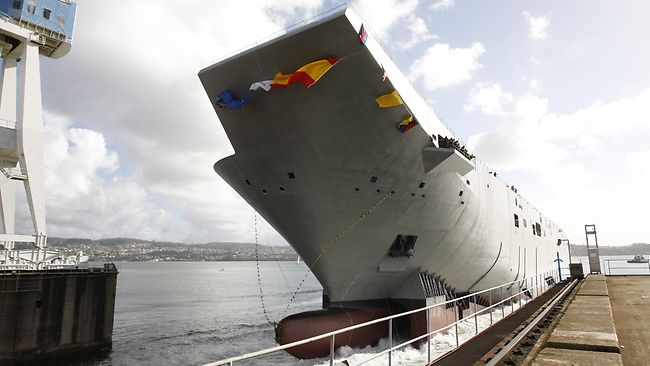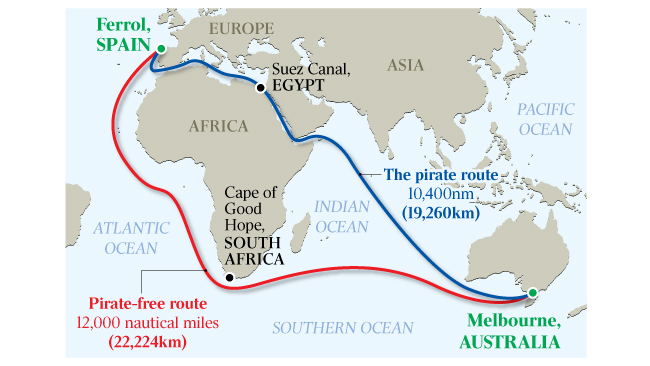The Australian
Tuesday, November 06, 2012
BY: CAMERON STEWART

The navy's newest amphibious ship, HMAS Canberra, rolls down the slipway in Spain. Picture: Defence Source: Supplied
FEARS Somali pirates could hijack the navy's biggest-ever warship as it was transported from Spain to Australia was a factor in the decision to send the ship on a 12,000 nautical mile journey around Africa.
The longer route kept the vessel away from pirate-infested waters, avoiding the embarrassing prospect of having armed pirates take control of the heavy-lift ship Blue Marlin, which was carrying the hull of the navy's future amphibious assault ship HMAS Canberra.
Concerns about the potential for a pirate attack were discussed in private meetings between Defence, the warship's Spanish builder Navantia and authorities for the Dutch-flagged Blue Marlin. Navantia made the final decision to take the ship the long way around Africa after informal discussions about the possibility of an Australian naval escort for the ship near Somalia came to nought.
A Navantia representative in Melbourne yesterday confirmed that the risk of piracy was "always a factor" in the decision to send HMAS Canberra via the Cape of Good Hope but he said other factors also played a part.
He said the passage through the Suez Canal, which is about 1600 nautical miles shorter, was complicated by complex regulations involving such large vessels and the time saved by sailing this shorter route was not significant. The Canberra Class ships are bigger than Australia's last aircraft carrier HMAS Melbourne, which was decommissioned in 1982, and will be more than 230m long and 27.5m high, with room for 12 helicopters and 100 armoured vehicles. Given all of these issues, the Navantia spokesman said it made sense, on balance, for the ship to take the safer but longer route.

The decision to take the 49-day, 12,000 nautical mile route around Africa is thought to have added up to two weeks' sailing and more than $2 million to the cost of the trip.
If Somali pirates hijack and then take control of a ship, their practice is to demand payment of a substantial ransom before they release it.
It is understood the Australian Navy debated whether to provide a frigate to escort the Blue Marlin but decided against it because of the operational commitments of its ship currently in the region, HMAS Anzac, which is part of a multinational force.
Another option discussed informally between the parties was to place armed mercenaries on the ship to help protect its cargo and its 60-member crew from possible attack as it sailed through the dangerous waters of the Gulf of Aden and the Arabian Sea. It is understood that Dutch authorities objected to armed guards being placed on the Dutch-flagged ship.
The Gulf of Aden and the Arabian Sea are considered among the world's most dangerous waters because of pirates, who can conduct attacks hundreds of kilometres off the coast. In 2001 pirates captured a series of giant oil tankers and held them for ransom.
However, the number of attacks has fallen in recent months because of international patrols, which have led to about three dozen warships patrolling the region.
The Blue Marlin carried HMAS Canberra into Melbourne's Port Phillip Bay on October 17 after its seven-week journey via the Cape of Good Hope.
The trip was slowed down by poor weather but was otherwise uneventful.
Navantia is contracted to build the hulls of the navy's two 27,000-tonne landing ships, with the rest of the ships being built by BAE Systems at the Williamstown shipyards,
The first ship, HMAS Canberra, is due to be delivered in 2014.
The second, HMAS Adelaide, is still undergoing hull construction in Spain and due to be delivered in 2015.
The amphibious assault ships, also known as a helicopter landing dock, will be the largest ships ever operated by the Australian navy.
The ships are larger than a normal aircraft carrier and will be able to land a force of more than 2000 personnel by helicopter and water craft as well as their weapons, ammunition, vehicles and stores.
The ships were ordered by the Howard government to allow Australia to move more troops to war zones and also to undertake large humanitarian operations.